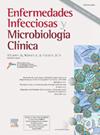Recently acquired hepatitis C: Epidemiological characteristics and treatment response in a large cohort of MSM living with HIV in Madrid
IF 2.6
4区 医学
Q3 INFECTIOUS DISEASES
Enfermedades infecciosas y microbiologia clinica
Pub Date : 2024-10-01
DOI:10.1016/j.eimc.2023.06.011
引用次数: 0
Abstract
Introduction
We analyzed epidemiological, clinical characteristics, and the response to treatment in people living with HIV (PLHIV) who recently acquired hepatitis C (RAHC) in a multicentre study in Madrid (Spain).
Methods
Multicenter, ambispective, observational study of RAHC in men who have sex with men (MSM) infected with HIV. Clinical, epidemiological, and RAHC evolution were recorded prospectively in 2019 and 2020 and retrospectively in 2017 and 2018. In patients who received HCV treatment, sustained virological response (SVR) was provided 12 weeks after the end of treatment in an intention to treat analysis (ITT): all treated patients were included; and in analysis per-protocol (PP): missing patients were excluded.
Results
Overall, 133 patients were included. Median (IQR) age was 40 (34.3–46.1) years, 90.9% had at least one previous sexual transmission disease (STD), and 33.6% had previously hepatitis C. More than half of the prospective sample included patients using chemsex related drugs (57.3%), 45.7% of them intravenously. The most prevalent genotype was G1a (66.2%), followed by G4 (11.3%). Ten of 90 patients evaluated for spontaneous cure (11%) cured the infection spontaneously, and 119 had treatment after a median time of 1.8 (0.7–4.6) months: sustained virological response (SVR) was achieved in 90.7% in the ITT and 94.7% in the PP analysis, with no differences regarding the direct-acting antiviral agents (DAA) combination used.
Conclusions
MSM infected by HIV with a RAHC were exposed to high-risk sexual behavior. Spontaneous cure rate was low, while SVR after treatment was achieved by more than 90%.
新近感染的丙型肝炎:马德里大批感染艾滋病毒的男男性行为者的流行病学特征和治疗反应
导言:我们在马德里(西班牙)的一项多中心研究中分析了最近感染丙型肝炎(RAHC)的艾滋病病毒感染者(PLHIV)的流行病学、临床特征和治疗反应。2019年和2020年对临床、流行病学和RAHC演变进行了前瞻性记录,2017年和2018年进行了回顾性记录。在接受HCV治疗的患者中,持续病毒学应答(SVR)在治疗结束后12周进行意向治疗分析(ITT):纳入所有接受治疗的患者;按方案分析(PP):排除缺失患者。中位(IQR)年龄为 40(34.3-46.1)岁,90.9% 的患者至少曾患一种性传播疾病(STD),33.6% 的患者曾患丙型肝炎。最常见的基因型是 G1a(66.2%),其次是 G4(11.3%)。在接受自发治愈评估的 90 名患者中,有 10 人(11%)自发治愈了感染,119 人在接受治疗后的中位时间为 1.8(0.7-4.6)个月:在 ITT 分析中,90.7% 的患者获得了持续病毒学应答 (SVR),在 PP 分析中,94.7% 的患者获得了持续病毒学应答 (SVR),在使用的直接作用抗病毒药物 (DAA) 组合方面没有差异。自发治愈率较低,而治疗后的 SVR 达到了 90% 以上。
本文章由计算机程序翻译,如有差异,请以英文原文为准。
求助全文
约1分钟内获得全文
求助全文
来源期刊
CiteScore
2.10
自引率
8.00%
发文量
194
审稿时长
29 days
期刊介绍:
Hoy está universalmente reconocida la renovada y creciente importancia de la patología infecciosa: aparición de nuevos agentes patógenos, de cepas resistentes, de procesos con expresión clínica hasta ahora desconocida, de cuadros de una gran complejidad. Paralelamente, la Microbiología y la Infectología Clínicas han experimentado un gran desarrollo como respuesta al reto planteado por la actual patología infecciosa. Enfermedades Infecciosas y Microbiología Clínica es la Publicación Oficial de la Sociedad Española SEIMC. Cumple con la garantía científica de esta Sociedad, la doble función de difundir trabajos de investigación, tanto clínicos como microbiológicos, referidos a la patología infecciosa, y contribuye a la formación continuada de los interesados en aquella patología mediante artículos orientados a ese fin y elaborados por autores de la mayor calificación invitados por la revista.

 求助内容:
求助内容: 应助结果提醒方式:
应助结果提醒方式:


